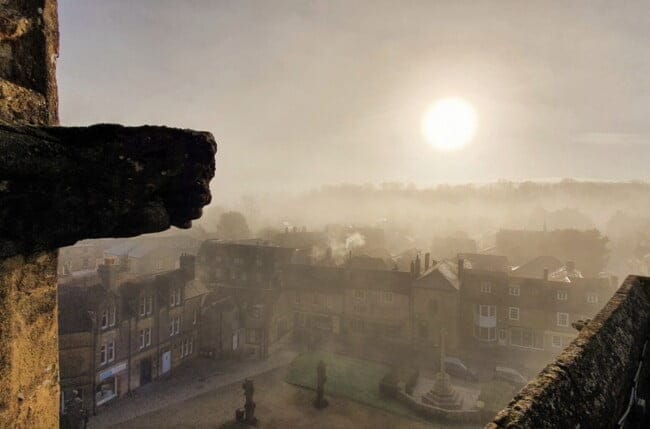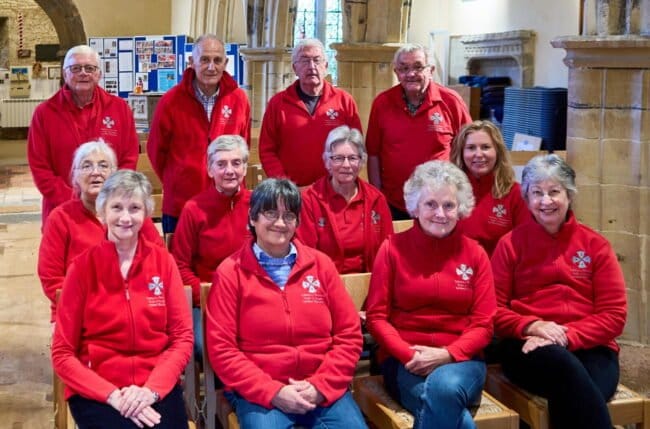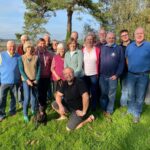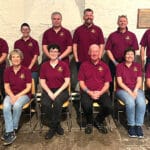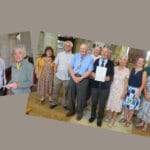The setting of the Church of St Mary the Virgin in Dinton, a small village in the Nadder Valley west of Salisbury, is amongst the most picturesque in the Diocese. The spacious and dignified church rises above a scene of stone cottages, both large and small, manicured lawns, and open parkland. The church itself, a handsome building, is largely 14th century, a fine example of what is known as the ‘Decorated’ or ‘Reticular’ style of Gothic architecture, a more mature and refined version of the Early English seen chiefly at Salisbury Cathedral. The large size of the church is somewhat surprising for a village with scarcely 700 residents. Still, it can be easily explained by its association with Shaftesbury Abbey, which at the time of the Dissolution, was the second-richest nunnery in England.

Dinton itself is far older than the abbey. Evidence for the continuous occupation of the land both in and around the village exists from the Neolithic and Bronze Ages, with human implements found in the surrounding downs, and at Dinton Beeches, the old coach road to Salisbury, now disused. Furthermore, Wick Ball Camp, which lies within Dinton Park and close to the church, is an univallate (a type of enclosure with a single line of ramparts guarding it) Iron Age hillfort. It is difficult to say with any certainty the history of the village itself. Still, as recorded in the Domesday Book, by 1086, the settlement was in possession of Shaftesbury Abbey, with twenty-one households; Dinton would remain in the possession of the nunnery until the Dissolution.
A church building is not mentioned in the survey, although this is not uncommon, as the Domesday Book was primarily a record of the landowners, not the buildings within it. We do not know when Dinton first had a church; the earliest mention of one is in 1160. However, we do know from the Domesday book that the land Shaftesbury owned also included the nearby hamlet of Teffont Magna, and early Saxon work has been found in the church there – it is possible a similarly early church building was founded in Dinton. The earliest work in the present building, which is largely a construction of the 14th century, is the north doorway, estimated from its style to be late 12th century. Certainly, this would tie in well with the record of the church in 1160.

The church is a cruciform building, with a central tower and transepts. The tower, which was heightened in the 15th century, contains a ring of six bells, three of which are 17th century and one of which, the tenor, is early 15th century. Dinton is part of a collection of churches in the area around Salisbury with central crossing towers, and most of them, to the interest of the ringer, are rung from the ground floor. These include Chilmark and Barford St Martin on the west side of Salisbury, as well as Britford on the east side. Except for Britford, all three have decorative stone vaults underneath the belfry, another rare feature of village churches, and indicative of the wealth of Shaftesbury Abbey.
Dinton appears to have had six bells since at least 1666, and four bells since at least 1539, when the early churchwardens’ accounts record the purchase of four new bell wheels. The accounts also show the third bell was recast in 1539 by Roger Eles (sometimes spelt Elys or Eyles) of Salisbury for £5 12d. The history of the next 150 years is a little hazy but gives the appearance that the treble was recast by William Purdue in 1660 (the predecessor of the present 3rd), who also added another bell (the present 2nd). In 1661, he also recast the 4th (the present 5th). The inscription on all three bells has his initials, WP, and his trademark tree decoration.
In 1666, Francis Foster added the present treble bell, to make a ring of six. Only thirteen bells by Foster survive in Britain today, and Dinton’s is the only one to survive in Wiltshire; the bell is consequently listed for preservation by the Church Buildings Council. The other bell listed for preservation is the tenor, cast circa 1400 by the Salisbury Foundry, alongside similar bells for Sturminster Marshall, Fontmell Magna, and Kington Magna, though Christopher Dalton is less than complimentary about the quality of Dinton’s casting in his unfinished Bells of Wiltshire series.
There appears to have been a major restoration in 1876 by John Warner & Sons of Cripplegate, who at the very least provided Dinton bells with new fittings, hung in a new oak frame, which still survives today, albeit in rebuilt form. The tower is not as large at the top as it is at the base, and as a result, it was only just possible to fit all six bells in on one level at the top of the tower. Another restoration took place from 1934-1936, funded by William Wyndham of Dinton House (now called Phillips House); the church backs onto the land at Dinton House. He provided a cheque for £300 for the recasting of the third and fourth bells, and then a further £44 for repair of the belfry floor.
The restoration, which was carried out by Mears & Stainbank of Whitechapel, London, involved removing the canons from the bells, replacing most of the fittings with modern equivalents (except the wheel centres, which appear to be Warners’ work), and the replacement of the fourth; the inscription on the old bell was reproduced in facsimile. They also attempted to weld the cracked third bell, but recast it in 1936 when this proved unsuccessful. Unusually, the two bells, despite being cast within 12 months of one another, have quite substantially different tuning: the third is square-shouldered and has old-style tuning, whereas the fourth has rounder shoulders and true-harmonic tuning. The frame was rebuilt utilising the existing oak trusses as part of this work, though to what extent it was changed, is unknown. All six bells swing in the same direction, north-south, which causes the frame to move whilst the bells are ringing, adding a certain amount of unpredictability.

From the point of view of the ringer, the most interesting, and daunting, fact about these bells is the position of the ringing chamber. Located on the ground floor at the centre of the church, with the nave pews behind you and the choir stalls in front of you, one feels decidedly small ringing here. The main difficulty with these bells, frame movement notwithstanding, is the length of the ropes – the vaulted ceiling is 23.75 feet (7.25 metres) high, and with no rope guides, they are something of a challenge, even for experienced ringers. Whilst they have a grandeur about them, especially when rung well, it is difficult to achieve good ringing here, with both long ropes, frame movement, and reasonably heavy bells all working against you. Nevertheless, they make a fine old sound, and are very useful for forcing one to ring with the correct technique – any slack rope or lack of follow-through leads to swift punishment from the bells!
Given the length of draught, they are likely to be a contender for the longest unguided ring in the whole of the Guild, possibly rivalled only by Britford. Ringing here is always an ‘experience’, but as one novice ringer who recently visited here said “It is towers like these where you learn the most!”. Ringing here is by the Nadder Valley ringers, who rotate around the towers of Compton Chamberlayne, Fovant, Barford St Martin, and Dinton, every Monday. Visitors are always made very welcome.
The tenor bell, cast in 1400 by the Salisbury Foundry.


